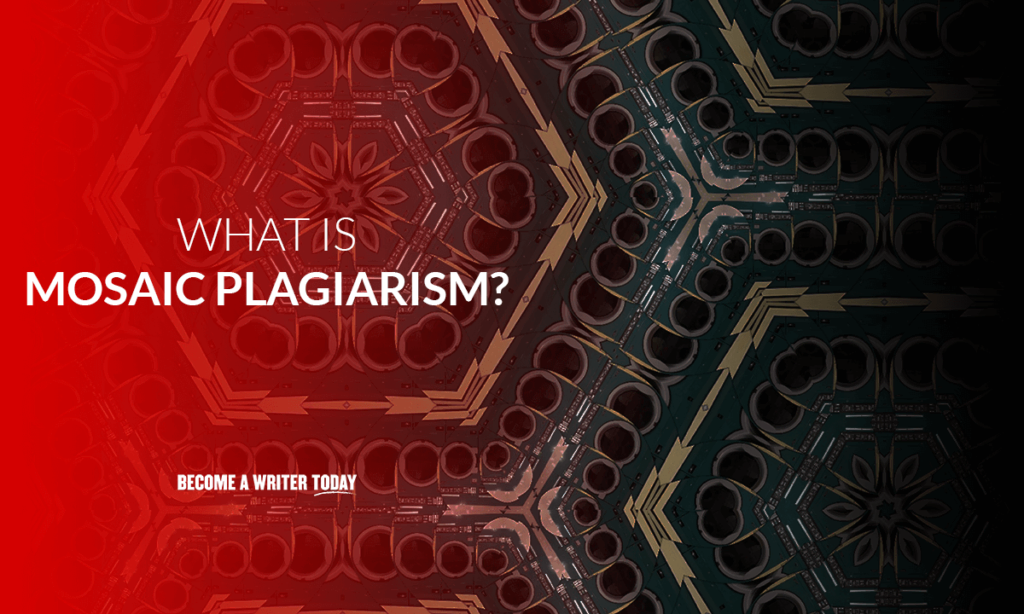What is mosaic plagiarism? Read on to see how you can spot and avoid this common type of plagiarism.
Mosaic plagiarism is one of the main common types of plagiarism. It is a serious offense that occurs when someone borrows from the works of other writers, then pieces those quotes and phrases together as a new piece with their name on it.
To write ethically, either in an academic setting or a professional publication, you must understand what is mosaic plagiarism and then take steps to avoid it. That way, you can publish ethical works you’re proud to call your own.
Contents
What Is Mosaic Plagiarism?

Westminster College defines mosaic plagiarism as “when a writer poorly paraphrases a statement, but their work has a similar sentence structure to the original source.”
This form of plagiarism also occurs when a writer copies and pastes bits and pieces of other works into their writing without proper attribution and quotation marks.
This type of plagiarism may be unintentional, but it is a form of academic dishonesty, regardless of intention. Mosaic plagiarism is also sometimes called patchwork plagiarism or patch writing. It’s easy to do it if you spend a lot time reading works by similar writers and fail to track and review your sources.
Forms of Mosaic Plagiarism
Mosaic plagiarism has one of two forms. The first is to copy the ideas from one single source. In this instance, the writer may use synonyms and change the sentence structure, but the main flow and ideas are identical to the source content.
Mosaic plagiarism also occurs when the writer has several original authors they pull from. The writer weaves these phrases and quotes into a new piece of writing but does not use citations.
What Are the Consequences of Mosaic Plagiarism?

The consequences of plagiarism are often severe. You may face disciplinary actions in an academic setting, including failing the course or getting expelled from school.
If you are in a research setting, your research can be null and void after you are found guilty of this kind of plagiarism. If you are publishing a book, the publisher can hold you in breach of contract if the work is found to contain anything other than original content or properly cited research.
Learn more about the consequence of plagiarism.
How to Avoid Mosaic Plagiarism
As a writer striving for professional and academic honesty, avoiding different types of plagiarism, including mosaic plagiarism, is vital. In short: any time you need to quote someone else’s original work or idea, use proper citations. Whether your teacher or publisher wants MLA or APA, learn the citation style and apply it to the writing.
If you include an exact or direct quote, use quotation marks to indicate the writing isn’t your own. Even with quotation marks, use an in-text citation to indicate the original author.
When possible, use a plagiarism checker to double-check academic work before submitting it. The website TurnItIn has a good program that can help check your work for signs of deliberate plagiarism.
Finally, if you’re a freelance writer or content publisher, we recommend buying the best plagiarism checker you can afford and using it to check works before hitting publish.
Remember that no checker is perfect. To protect your reputation, take care that you always cite other people’s ideas and or include or point to your sources.
A Final Word on What Is Mosaic Plagiarism?
Mosaic plagiarism is a common form of plagiarism, especially in academic settings. It occurs when someone creates a mosaic of different writers’ thoughts and ideas, then passes it off as their own without citing the original authors.
Like all forms of plagiarism, mosaic plagiarism has serious implications, both for your immediate academic career and your future professional life.
FAQs on What Is Mosaic Plagiarism
What is the difference between paraphrasing plagiarism and mosaic plagiarism?
Mosaic plagiarism occurs when the majority of a work is pieces and bits from the work of other writers. Paraphrasing plagiarism occurs when you paraphrase another author’s ideas but do not cite them. This type of plagiarism can be part of mosaic plagiarism.
What is an example of mosaic plagiarism?
If an original source says this:
“Many people think of plagiarism as copying another’s work or borrowing someone else’s original ideas. But terms like ‘copying’ and ‘borrowing’ can disguise the seriousness of the offense.” (What Is Plagiarism from Plagiarism.org)
Mosaic plagiarism may write it like this:
Copying another person’s work or borrowing original ideas from someone else is what many people consider plagiarism. The words “copying” and “borrowing” can make people feel like this is not quite as serious as it really is.
The sentence structure and basic ideas are identical between these two, making it an example of mosaic plagiarism. To fix it, the writer could leave the paraphrase and add a citation with a link to the original source.